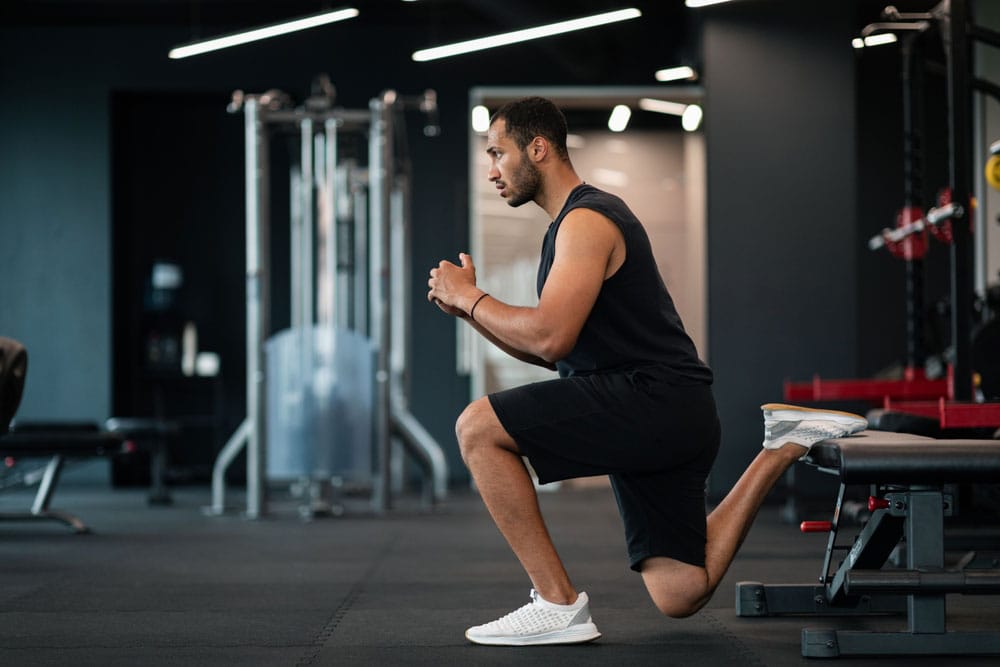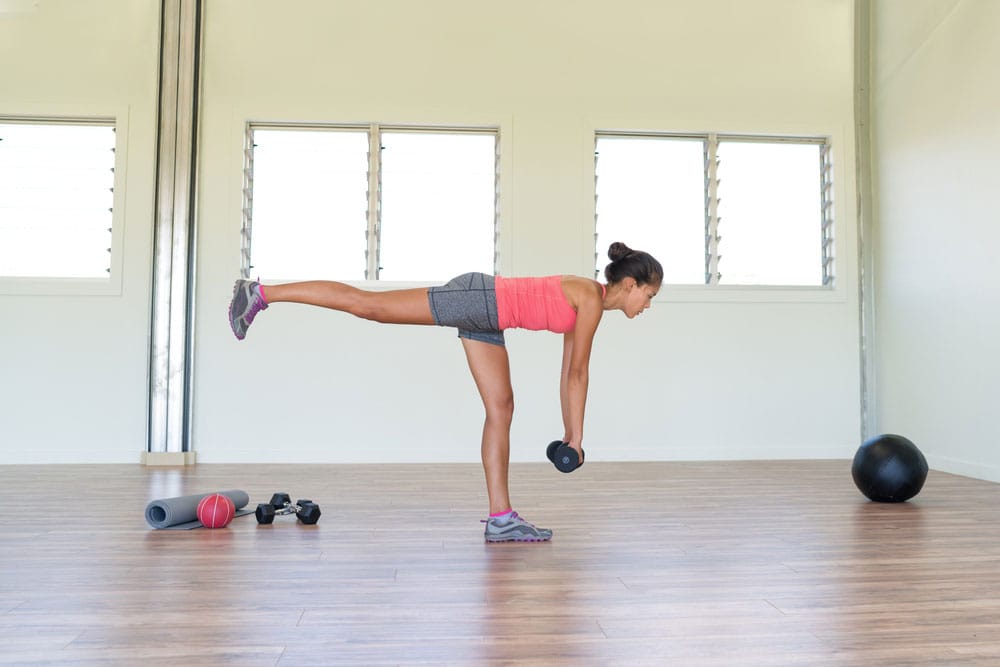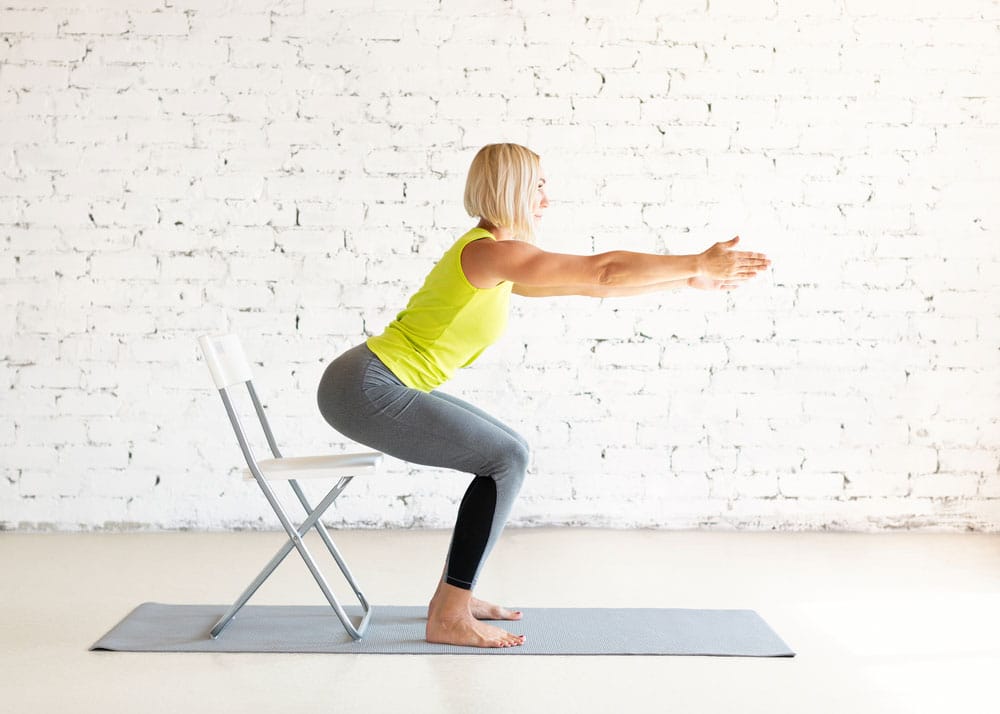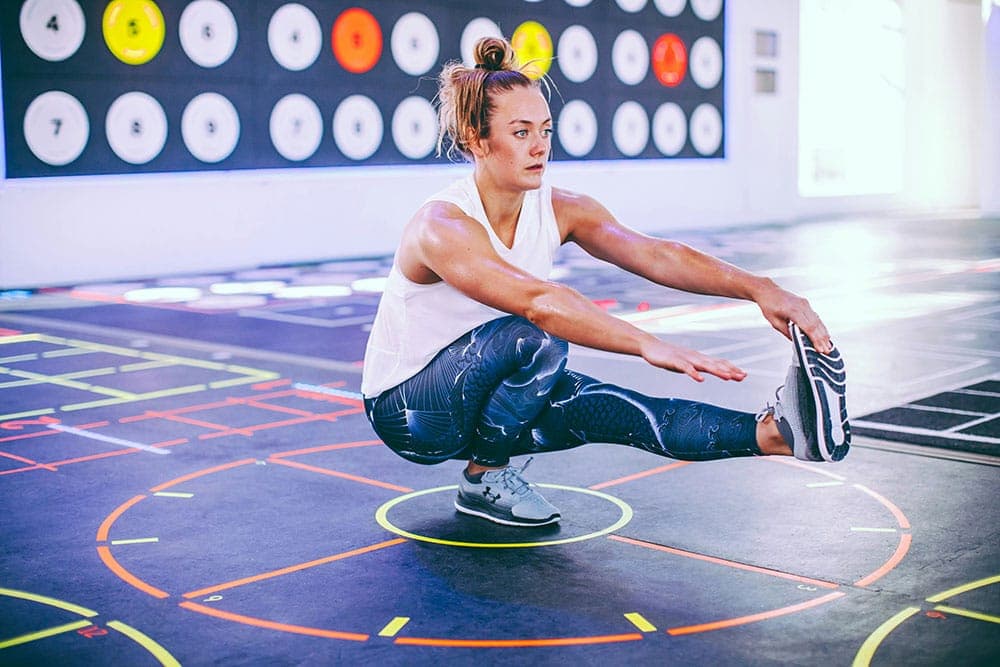Pistol Squat Progression: 8 Move to Ace Your Pistol Squat
This is a guide to help you learn the basics of pistol squat progressions. These simple progressions will help you work up to a pistol squat.
Pew pew!
Fire it up. (Your quads).
It’s time for some pistol squats.
Let’s unpack one of the most challenging squat variations you’ll ever do. Are you up for the challenge?
Behold the mighty pistol. Today, we’re taking a trip through pistol squat progressions. These tough moves will get you stronger legs and a solid core until you can work up to the full shebang.
Pistol Squat Requirements
Ankle Mobility
When you drop your body into a pistol squat, your ankle is coming into one of the deepest forms of dorsiflexion that it will likely ever see.
Dorsiflexion is when your foot comes toward your shin across your ankle joint. because you drop so low in a pistol, your ankle has to do a lot of the heavy lifting. to make matters even more challenging, you have to support your body weight on one ankle instead of two like you would in a regular squat.
It can be handy to do a mobility test before you try to pistol squat. this will help you understand whether or not you have enough ankle flexibility to come all the way down into a full pistol squat.
If not, focus on moves that work your ankle mobility. Try some ankle rolls and calf raises to work on getting those ankles strong and flexible.
Anytime you want to train your pistol squats. use an ankle warm up beforehand. hint: it's a good idea to train ankle Mobility before you do traditional squats as well.
Knee Strength
If you have weak knees, you may struggle to get into a pistol squat. Like with your ankles, putting all of your weight on one leg in a single leg move is very taxing on a joint. Moves that requires a deep bend can be especially hard if you've had an injury.
Weak Quads
Although a pistol squat will work all the muscles of your leg, including your glutes, calf muscles, and hamstrings, this move can really set your quadriceps on fire.
Because of the deep range of motion and the huge bend in your knee, a lot of the effort is redirected to your quadriceps muscle on the front of your leg.
Lack of Core Strength
Although this is a big leg move, your core plays a huge role in stabilizing your pistol squats.
Since you’re balancing on one leg, it's far more challenging than a traditional squat where you have both legs to serve as a base.
Because of this, your core will have to do a lot more activation to keep you upright.
Tight Hip Flexors
Finally, because of the depth of your bend, a pistol puts a lot of strain on your hip flexors.
If you drop into a focus still squat, your hips are usually engaged in deeper flexion than a traditional squat, going even further than 90° into the bend.
If your hips hurt when you squat regularly, you may need to take some more time training other types of squats, like the barbell back squat, or even unweighted squats to practice before you consider pistol squats.
Okay, so if you're still with us and none of those considerations scared you off, here's how we're going to get into our pistol squats.
Let's break it down step by step and look at some progressions you can take to work toward a full pistol squat.
Bulgarian Split Squats

All my homies hate Bulgarian split squats and that's why they're such a perfect move to train when it comes to getting your pistols.
If this move has you in agony as well, that means it's working.
Bulgarian split squats are one of the best ways to get familiar with single-legged moves that have a lot of intensity.
- Set-Up: Stand with feet hip-width apart, facing away from a bench or elevated surface.
- Action: Take a step back with one foot, placing the top of your foot on the bench behind you. Plant your working foot firmly to create a solid base. Drop down by bending your front knee to lower your body. Keep your torso and shoulders upright in a neutral position.
- Position: Aim to lower your back knee toward the ground but don’t quite touch it. Keep a 90-degree bend in both knees.
- Return: Drive through the heel of your front foot to return to your starting position.
- Reps: Complete the desired number of reps on one leg before switching to the other. Aim for 3-4 sets of 8-12 reps.
Single-Leg RDL

This tricky move will help you work up to the balance you need to perform a full pistol squat.
The single-leg Romanian deadlift (RDL) is one of the best ways to correct imbalances in your muscles.
Most of us, whether we know it or not, tend to be either right-side dominant or left-side dominant.
Training single-leg moves can help with balancing out your body so your squats will be equal on both sides.
For a single-leg RDL:
- Preparation: Stand on one leg, keeping a slight bend in your knee. Grab a medium to heavy dumbbell or kettlebell. Hold it in your opposite hand to your standing leg. This helps you create a counterbalance.
- Action: Hinge at the hips, extending your free leg straight back while lowering your weight down towards the ground. Keep your back straight and your chest up. Your spine should be in a neutral position the whole time. Keep lowering your weight down until your body and free leg are parallel with the ground.
- Return: Engage your glutes and hamstrings to pull yourself back up to the starting position.
- Reps: Keep going for as many reps as you like on one leg, then switch to the other. Make sure you get an even number of reps in on both sides. We recommend 3 sets of 10 reps on each leg.
Pro Tip: If you're new to this exercise or struggle with your balance, start with no weight. You can even hold a box, wall, or the back of a chair for support as you're lowering your body forward when you're starting.
Send your gaze out and slightly ahead of you rather than straight down. Keep the eyes locked in one place. This will help you hold your balance if it's something you struggle with.
Chair Pistol Squat

In this progression, we’ll be training the same movement as a pistol squat, but only half of the way.
This will help you train your entry into the movement, making sure that you're attacking your pistol squats from a place of strength and command.
For this variation:
- Equipment: Grab a chair, box or weight bench. Set it up next to you and step a comfortable distance away so that you'll be able to lower your butt onto whatever seat you choose.
- Preparation: Inhale, then exhale slowly as you start to drop into your squat. Engage the abdominals, keeping a straight spine as you lift one leg straight ahead of you. Bend the knee of the other leg, keeping your toes pointed ahead and send your hips back to drop your seat.
- At the bottom: Lightly tap your hips on the chair, but do not come to a full seat here. Instead, drive back through the leg to push yourself up.
- Reps: Continue this progression for 3-6 reps per leg.
Pro tip: Consider training the chair progression as a negative as well. In this variation, start sitting down on your chair, bench, or block, then focus on driving up through your foot to push yourself to a standing position to practice the up part of your movement.
Pay close attention to your chair progressions. What part of the squat are you struggling with most? Is it lowering yourself down with control? Or driving yourself up from the bottom of the movement?
We highly recommend incorporating the negative into your move here to understand what your “sticking point” is in your pistol squat.
Negative Pistol Squat
This may seem odd, but training negative pistol squats before traditional pistol squats may help you overcome some of the mental barriers that you're facing in this move.
Specifically, for people who struggle to get the explosive burst of power they need to drive up and out of one leg to bring them to a standing position, training a negative can be more beneficial than training the traditional squat.
When you start from the top, you have the help of gravity on your side. This force helps to lower your body downward.
But from the bottom, you have to use your core strength and raw power in your legs to generate enough action to push yourself out of your joints so they don't lock and to stay stable to balance on one leg.
To perform a negative pistol squat:
- Starting Position: Start crouching down to the ground with one leg fully extended in one knee bent.
- Action: Drive out of your standing leg, engaging your abs and your leg muscles to drive your body upwards. Extend your arms out in front of you to keep your balance.
- Reps: Continue this progression for three to six reps per leg.
Training a full negative pistol squat is even more eye-opening than the chair progression in terms of where you may be struggling.
Full Pistol Squat
Now we've got the real deal. After training these progressions, hopefully, you feel ready to come down into a full pistol squat.
If you're still struggling with mobility somewhere in this move, keep working on your progressions for a few more weeks.
To come to a full pistol squad:
- Set-Up: Slowly start to extend one leg in front of you while bringing both arms straight ahead to keep your balance. Contract your core for stability.
- Action: Bend into your standing leg, continuing to sweep your leg out in front of you as you squat your body down towards the ground. Continue to drop into this move until your thigh drops below a 90° angle with the ground, and your seat is just hovering above the ground.
- Upward Motion: Quickly, as you approach the ground, drive into your standing leg to explosively push out of your foot and reverse the direction of your movement. Continue to balance on your standing leg as you drive your body up and back to a standing position.
- Reps: Repeat 3-5 times per leg.
Pro-Tip
Especially in the full variation of your pistol squat, you'll want to be aware of any previous injuries or joint sensitivity you may have.
This movement is very tough on your knees, hips, and ankles. If you experience any pain, move back to one of the earlier progressions, or take a break to stretch.
Remember, it's not worth it to hurt yourself in this move. Any pattern of movement that causes injury or strain is likely to force you to take more time off training than you would like to.
This will set you back more than simply working up through the progressions until you're ready to come to a full pistol squat.
Don't feel discouraged if you can't get it right away. The pistol squat is a very advanced squat variation. Wherever your body is today is enough. You should feel proud of whatever level you come to in this progression.
Pistol Squat Mistakes
The pistol squat is very technical compared to other squat variations and requires a lot of finesse. Because of all the components that go into it, many people tend to make mistakes.
Here are a few errors to watch out for.
Crunching the Toes
To stay balanced, many novices have the bad habit of crunching their toes not only in pistol squats but in any posture that requires balancing for a long time.
The intention behind this mistake is to grasp at the ground in hopes of staying up. But by crunching up your toes, you're creating less of an even surface for yourself to balance on.
Instead, think about balancing evenly between the edges of your feet. Try to ground your big toe, your pinky toe, and your heel with even pressure to make a tripod shape.
This should give you a better sensation of what you should feel in your feet when you balance.
Lifting the Heel
Our heels have a tendency to lift in this movement especially when we bend too far forward (we’ll come to this in the next point).
But rising up on to the ball joint of your foot also gives you less of a stable platform for balance.
Aim to keep your heel planted firmly on the ground through this movement. If your heel starts to lift, it's possible you don't have enough ankle mobility to perform this move.
As we mentioned at the start of this article, a pistol squat requires intense dorsiflexion of the ankle.
If your ankle doesn't want to bend that way, your foot might compensate by bringing the heel up. You may also notice differences in the move between standing on your right vs. left foot.
If this is happening to you, take some more time to work on stretching out your ankles before you attempt this move.
Hunching Your Back
Although your body will naturally lean slightly forward in a pistol squat, what you don't want to do is to hunt your shoulders or deeply curve your spine forward.
You want to think about growing taller in this movement to keep your head on a straight axis with your working leg.
This way, you won't throw yourself off balance. If you find yourself bending forward, go back to the chair progression, and see what part of the movement is causing you to hunch over.
You may need to work on more ab-strengthening moves or develop better core strength before attempting a pistol squat if you have a tendency to hunch.
All of these mistakes indicate not being ready to attempt this move. And that's okay, pistol squats are very advanced.
If you need a little bit more training, take some time to work on your ab strength, leg strength, and the flexibility and mobility of your hips, knees, and ankles before training a pistol squat.
As a rule of thumb, you'll want to be able to complete several full reps of traditional squats before you attempt pistols.
Make sure that in your traditional squats, you're able to drop below a 90° angle in your range of motion.
The Takeaway
Pistol squats are one of the hardest variations of a squat that you can master. This single-leg bodyweight move requires immense balance to lower your body down to the ground and back up.
Pistol squats work your glutes, hamstrings, and quads, as well as your core, knees, and hip flexors.
Single legged squats are some of the best moves to improve your balance. Alternating side to side between your right and left leg is a great way to correct muscular imbalances. Although they focus on your legs, pistol squats are a total body type of physical activity.
The movement pattern of a pistol squat helps you unlock most of your major muscle groups to keep balance. Single leg exercises with just your bodyweight are great to combined with strength training moves too.
Because of the deep flexion, especially at your knee hip, and ankle joints, make sure you're doing adequate warm-ups to wake up these parts of your body.
Stretching for Pistol Squats
You'll want to stretch these areas after you have performed your pistol squats too.
For some one-legged progressions to master before pistol squats, start with single leg RDLs and Bulgarian split squats
These will help you understand the intensity of pistol squats. They put all of your work into one leg, and force you to work your balance in a new way.
After that, we recommend starting with a chair progression. This lets you train the same motion as a pistol squat only using half the range of motion.
If you have a point in this move where you lose stability or begin to get stuck in the movement, you may start to notice it in this progression.
A negative pistol squat is the next step up. In this version, you drive yourself up out of the bottom of your pistol squat toward the top. Working at your pistol squat from the ground instead of from standing lets you further examine any sticking points or areas where you lack balance.
One mistake that many newbies to pistol squats make is getting stuck at the bottom. If you can figure out why you may be stuck on the ground in a negative, it will help you work around the issue or figure out any additional muscles you need to strengthen before trying to continue with this move.
References:
Guillén-Rogel, P., San Emeterio, C., & Marín, P. J. (2017). Associations between ankle dorsiflexion range of motion and foot and ankle strength in young adults. Journal of physical therapy science, 29(8), 1363–1367. https://doi.org/10.1589/jpts.29.1363
Related articles


Get fit with Flex
Build muscle & lose weight fast for free.
Available on iPhone + Apple Watch





